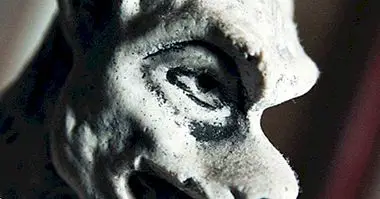Bálint syndrome: causes, symptoms and treatment
The visual system is one of the most valuable sensory systems developed for the human being. Thanks to him we are able to detect the presence of the different elements that are part of our environment as well as to identify their shape, proportions and position in space and in relation to us.
However, sometimes this system may be damaged for some reason, or the brain areas responsible for its management or the interpretation of the data derived from it may do so. One of the medical problems or syndromes that can result from brain injuries is Bálint syndrome .
- Maybe you're interested: "The 15 most frequent neurological disorders"
Balint syndrome: what is it?
The so-called Bálint syndrome is a medical picture caused by the presence of brain injuries and characterized by the presence of different alterations linked to the control of the visual system that hinder and even prevent the adaptive use of said system, highlighting the optic ataxia, the oculomotor apraxia, the perceptive problems and the difficulties derived from them, such as visual agnosia. This can be a serious detriment to the daily life of the person, who loses much of the functionality.
- Related article: "Apraxia: causes, symptoms and treatment"
Basic symptoms
Specifically, this syndrome is characterized because those who suffer from it have optic ataxia, that is, the inability to correctly coordinate the visual information and the movement of the hands. The subject is unable to perform tasks that require this coordination , although his visual perception and his motor system work properly separately.
Oculomotor apraxia also appears, which in this case refers to the inability to modify the focus of visual attention due to the absence or reduction of voluntary control of ocular activity. The gaze remains fixed at one point and it is complicated or impossible to change it regardless of whether stimulation is present at another point of the visual field, or else it presents erratic movements.
Another of the main symptoms of Bálint syndrome is simultanagnosia, in which the subject is not able to observe more than one object at a time without the previous ones disappearing from the perceptive field. The subject has serious difficulties in capturing complex visual stimulation, which he may not understand. In addition, there is often a high degree of disorientation in space.
Finally, it is also common to see alterations such as visual agnosia, in which the person suffering from this syndrome is unable to understand or identify what they are seeing and which can lead to phenomena such as prosopagnosia or the absence of face recognition.
- Maybe you're interested: "The 5 types of agnosia (visual, auditory, tactile, motor and body)"
Causes of this syndrome
The Bálint syndrome is caused mainly by the presence of bilateral brain injuries in which both parietal lobes are affected, especially in the areas in contact with the occipital. Between these zones the angular gyrus can be found, which in turn can cause cognitive alterations, disorientation and problems of association between language and image.
The causes of these injuries can be multiple, from the presence of strokes to traumatic brain injuries that affect those areas. In addition to this can be found some cases caused by neurodegenerative diseases, such as dementia. It also occasionally appears in complications derived from HIV infection, as well as in prion disease.
Functional alterations in patients
Those individuals with Bálint syndrome have serious problems to continue normal daily life. They have difficulties coordinating vision and motor skills and may not perceive correctly what surrounds them . Aspects such as dressing or feeding are greatly complicated in some cases, as well as any activity that requires fine motor skills and vision. Literacy is difficult or impossible, as is driving or handling delicate machinery. Sometimes there may be communication problems in the presence of agnosia or the difficulty of associating concepts with their corresponding images.
In addition, since it usually appears abruptly, it is an important interruption that It can generate serious psychological effects , not being rare to experience anxiety, anguish and even in some cases depression.
Treatment
Bálint syndrome is the result of a severe brain injury, so the treatment is dedicated to improving and trying to recover the lost functions from the rehabilitation. In most cases, an approach focused on occupational therapy (either through traditional means or through the use of new technologies) is used, which allows the patient to reduce his or her difficulties and enhance their abilities, as well as counseling and treatment. psychological in the required cases.
It is possible to achieve a certain level of recovery although it will depend on the type of injury that has caused the syndrome, the state of the damaged or isolated neurons and the use of strategies to recover or compensate or the typical functions of the injured areas.
Bibliographic references:
- Clavagnier, S. (2007). Balint's syndrome: disoriented vision. Mind and brain. 22
- Feinberg, T.D. and Farah, M.J. (1997). Behavioral Neurology and Neuropsychology. New York: McGraw-Hill.
- Rodríguez, I.P .; Moreno, R. and Flórez, C. (2000). Ocular motor disorders in Balint syndrome: computer-assisted occupational therapy. Motor Magazine, 6; 29-45. Complutense University of Madrid.



















